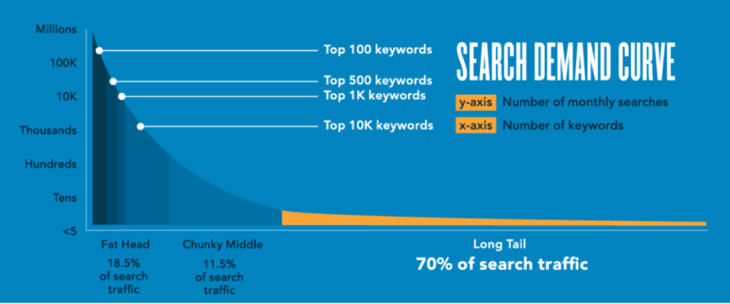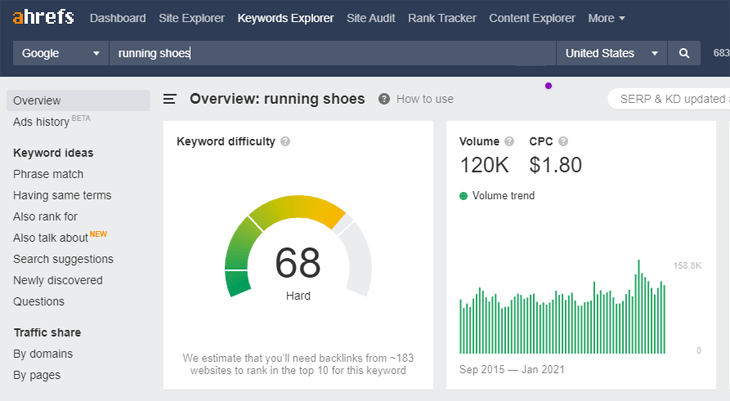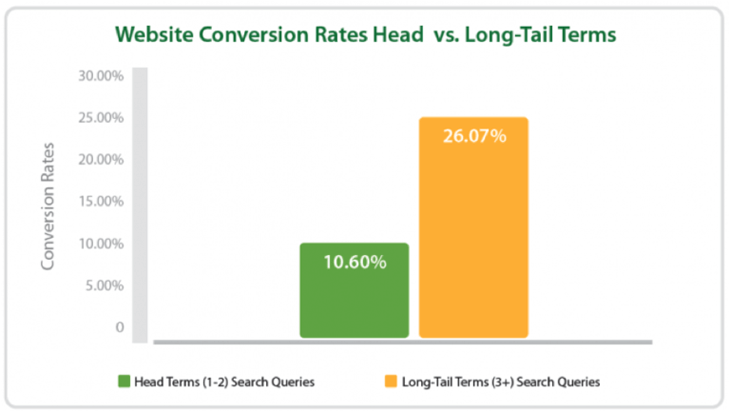Would you like to know how to find long tail keywords that can help you boost your traffic?
Studies show that 54.31% of search queries contain 3 or more words. These are called long tail keywords, and optimizing your content for them can help increase organic traffic, improve rankings on Google and boost conversions.
In this post, we’ll show you how to find long tail keywords and use them to increase organic traffic, as well as boost rankings and conversions. We’ll also explain what long tail keywords are and why they are important for SEO.
If you want to jump straight to a section, you can use these quick links:
In This Article
What Are Long Tail Keywords?
Long tail keywords are longer phrases people enter in search engines when they’re looking for something specific.
Often, they’re 3 or more words in comparison with short tail keywords that are usually 1 to 2 words. And they can help increase organic traffic, dominate search engine rankings, and boost conversions.

In fact, long-tail keywords make up 70% of search traffic. So, if you want to get more organic traffic and improve your SEO rankings, you should definitely use long tail keywords in your content.
Here’s an infographic from OptinMonster illustrating long-tail keywords and how they offer a higher conversion rate and less competition than short-tail keywords.

As you can see, the longer the phrase, the more specific it is, and the fewer search results there’ll be when people type it in.
The competition is less, and the conversion rate is higher. This makes up for great ranking opportunities!
Let's give you an example of a long vs. short tail keyword…
Long-tail Keyword Example
A person is about to purchase running shoes and is browsing Google. An example of a long tail keyword search would be: “buy running shoes for flat feet”. On the other hand, a short tail keyword search would be: “buy shoes”.
Did you see the difference?
Long tail search terms are not only longer, but have a very precise search intent, which is one of the most important rankings factors on Google. It tries to understand the intent behind every search query and matches it with the best results.
So using long tail keywords in your content will help you dominate the search results for low-competition keywords with a high search intent.
On the other hand, short tail keywords are broader and provide information to users when they’re in the early stages of purchasing a product or searching for information.
That said, let’s take a look at why long tail keywords are important for SEO?
Why Are Long Tail Keywords Important for SEO?
Long tail keywords are important for SEO since they can help increase organic traffic, dominate search engine rankings, and boost conversions. They can also help less established websites to rank in search engines and get ahead of their competition.
Here’s a detailed look at why you should be using long tail keywords…
1. Long Tail Keywords Are Easier to Rank for on Google
Given the vastness of the internet and high competition on common keywords, long tail keywords are easier to rank for on Google.
That’s because they are so specific that not many businesses would be competing to grab the top spot on the search results of Google. They generally have a lower search volume, which makes them less targeted by the “big players” online.
For example, if you use a keyword research tool like Ahrefs, you can see that the search volume for the long tail keyword phrase: “running shoes for flat feet” has an average of 4.0K monthly searches. It also has low keyword difficulty, meaning how hard it is to rank in the top 10 search results for that keyword.

On the other hand, the short tail keyword: “running shoes” has an average of 120K monthly searches and keyword difficulty of 68, which means it has more competition and is harder to rank for on Google.

That’s why a better strategy is to target long search phrases with less competition and a more specific search intent.
Another reason for using long tail keywords is that they can help you generate sales and grow your business, as we’ll explain next.
2. Long Tail Keywords Have a High Conversion Rate

When a user is in the final stages of the buying cycle, it’s more likely that they’ll use long tail keywords to find exactly what they’re looking for and then make a purchase.
In fact, long tail keywords have 2.5X higher chance of converting than short tail keywords. This means that long tail keywords will help boost CTR (Click-Through-Rate) in search results.
So, if you’re looking to grow your business, you should definitely target long tail keywords as they'll boost your conversion rate.
Want to avoid keyword stuffing?
Check out our list of the top keyword density checkers for WordPress.
Now, let’s take a look at how to find long tail keywords next.
How to Find Long Tail Keywords?
Here are 3 quick and easy ways to find long tail keywords:
1. Use AIOSEO’s Get Additional Keyphrases by Semrush Tool
An easy way to find long tail keywords is by using the best SEO plugin for WordPress, All in One SEO (AIOSEO) and its get additional keyphrases by Semrush tool.

AIOSEO is a powerful WordPress SEO plugin boasting 3+ million active users. Many brands and bloggers trust the plugin to help them boost their search engine rankings and traffic. That’s because the plugin has many powerful features and modules to help you properly configure your SEO settings.
For step-by-step instructions on how to install AIOSEO, check our detailed installation guide.
To find additinal keywords, scroll down in the post or page you’re editing to the AIOSEO Settings, and click on the General tab. Next, add your focus keyword.

After you’ve added your Focus Keyphrase, you simply click on the Get Additional Keyphrases button.

This will open a new window with Additional Keyphrases by Semrush. And if you don’t already have a Semrush account, it will ask you to create one and connect AIOSEO. It’s super easy and straightforward!

Anyhow, here you can find examples of additional keyphrases and even see their search volume and trend straight from the screen. Here you can see which search term is a highly targeted long tail keyword that would be a good option to add to your content.
Once you’ve decided which keyphrase to use, you simply click on the Add Keyphrase button, and it gets added to your content.
As simple as that!
Best of all, AIOSEO even gives you an SEO analysis of how well you’ve optimized your long tail keyword in your content.

As you can see, we haven’t optimized our content on this long tail keyword, but you get the point. The red bullet points are recommendations on what you need to improve to maximize rankings in search engines and drive more organic traffic to your site.
It also checks for keyword density, so you don't accidentlly over-optimize.
These tips are super useful if you want to boost your SEO and get ahead of your competition!
2. Use AIOSEO's Search Statistics
Another easy way to find long-tail keywords in WordPress is to use AIOSEO's Search Statistics module.

Search Statistics is a powerful tool that pulls data from Google Search Console (GSC) and presents in an easy-to-understand way in your WordPress dashboard. Some of the data Search Statistics shows includes:
- Keyword ranking
- Content ranking
- Search impressions
- Total clicks
- Average CTR
- And more
To find long tail keywords for your content, simply go to the Keyword Rank Tracker » All Keywords.

Scrolling down in this section you'll find the Keyword Performance section.

Here, you'll see all the keywords you're ranking for. You'll notice that most of them are long-tail keywords. If you haven't included them in your content, you can add them to better optimize your content for better search rankings.
For more information on using the Keyword Rank Tracker, check out our tutorial on checking your keyword rankings.
3. Use LowFruits
There are many keyword research tools on the market. But when it comes to long-tail keywords, I've found LowFruits to be one of the best.

This powerful tool scrapes the SERPs to find low-hanging keywords you can target to rank faster in search engines.
Besides the low-hanging fruits you get from LowFruits, other keyword types to consider are long-tail and short-tail keywords. Here’s a brief summary of each
- Long-Tail Keywords: Long-tail keywords are longer, more specific phrases. They usually have lower search volumes but higher conversion rates because they target more specific search queries.
- Short-Tail Keywords: Short-tail keywords are broader and more general. They typically have higher search volumes but are more competitive and less likely to convert.
A feature I've found tremendously useful in LowFruits is the Clusters feature in the keyword report.

This groups related keywords together, making it easy to create topic clusters. Coupled with AOSEO's Cornerstone Content feature, you can quickly build topical authority around that keyword. As a result you can rank faster for many keywords and drive more traffic to your site.
In short, if you're looking for a super easy to do keyword research for long-tail keywords, LowFruits is it.
4. Look at Your Google Search Console Report
Another option is to check your Google Search Console (GSC) report for the long tail keywords that are already bringing traffic to your site. This will help you find similar search terms that you can target or you can use the data to improve your existing content.
To easily do this, you can use the best WordPress Analytics plugin, MonsterInsights. It lets you view your Google Search Console reports directly inside your WordPress dashboard.
And when using the Search Console Report, you can see the top keywords that get the most clicks, impressions, CTR, and their average position.

As you can see from the above screenshot, almost all the top keywords are long tail keywords. These are the search terms that bring the majority of organic traffic and improve the CTR of your website.
The next step is to improve your existing content for these long tail keywords or find new similar ones. You can do that by using Google autocomplete, people also ask, or related searches.
5. Use Google Autocomplete, People Also Ask, or Related Searches
Another simple way of finding long tail keywords is by entering a short tail keyword or your main keyword in Google (don’t hit enter) and then look at the autocomplete suggestions.
These are more specific search queries that people look for and are related to your overall topic.
For example, if you type in “content optimization” in Google, you’ll see these autocomplete suggestions:

This way, you can get many long tail keyword ideas to optimize your content on.
You can also look at the People also ask section. For instance, when you enter a search term on Google, you’ll notice a set of questions under a box called People also ask.

Using Google, it’s easy to get long tail keyword ideas.
And there’s even one more way…
If you scroll down to the bottom of the page, you’ll find more suggestions by Google in the Related Searches section.

Now you have many good search phrases to choose from.
Once you've checked that your long tail keywords have enough search volume, the last step is to create content and optimize it for your keywords so that you can increase organic traffic, SEO rankings, and conversions.
And there you have it!
You have found long-tail keywords for your content.
How to Find Long-tail Keywords: Your FAQs Answered
What are long tail keywords?
Long tail keywords are specific search phrases that typically consist of three or more words. They are used by individuals looking for particular information or products, such as “best running shoes for flat feet.” These keywords help increase organic traffic and improve search engine rankings.
Why are long tail keywords important for SEO?
Long tail keywords are crucial for SEO because they generally have lower competition and higher conversion rates. They allow less established websites to rank more easily in search results, driving targeted traffic that is more likely to convert into sales.
What is the best tool for finding long-tail keywords?
The best tool for finding long-tail keywords is LowFruits. It's a revolutionary keyword research tool that scrapes SERPs and helps you find weak spots you can capitalize on to rank faster. If you're a WordPress user, you can also use AIOSEO's Keyword Rank Tracker to find long-tail keywords.
Final Word
We hope this helped you understand how to find long tail keywords and increase organic traffic. You may also want to check out other articles on our blog, like our guide to common SEO mistakes to avoid or our article on the benefits of SEO for small businesses.
As for what's next, we recommend you learn how to do a keyword gap analysis and check your competitors' keywords. This will help you become more competitive in the search landscape. You should also read up on the future of keyword research, as the landscape continues to evolve.
If you found this article helpful, then please subscribe to our YouTube Channel. You’ll find many more helpful tutorials there. You can also follow us on X (Twitter), LinkedIn, or Facebook to stay in the loop.
Disclosure: Our content is reader-supported. This means if you click on some of our links, then we may earn a commission. We only recommend products that we believe will add value to our readers.

